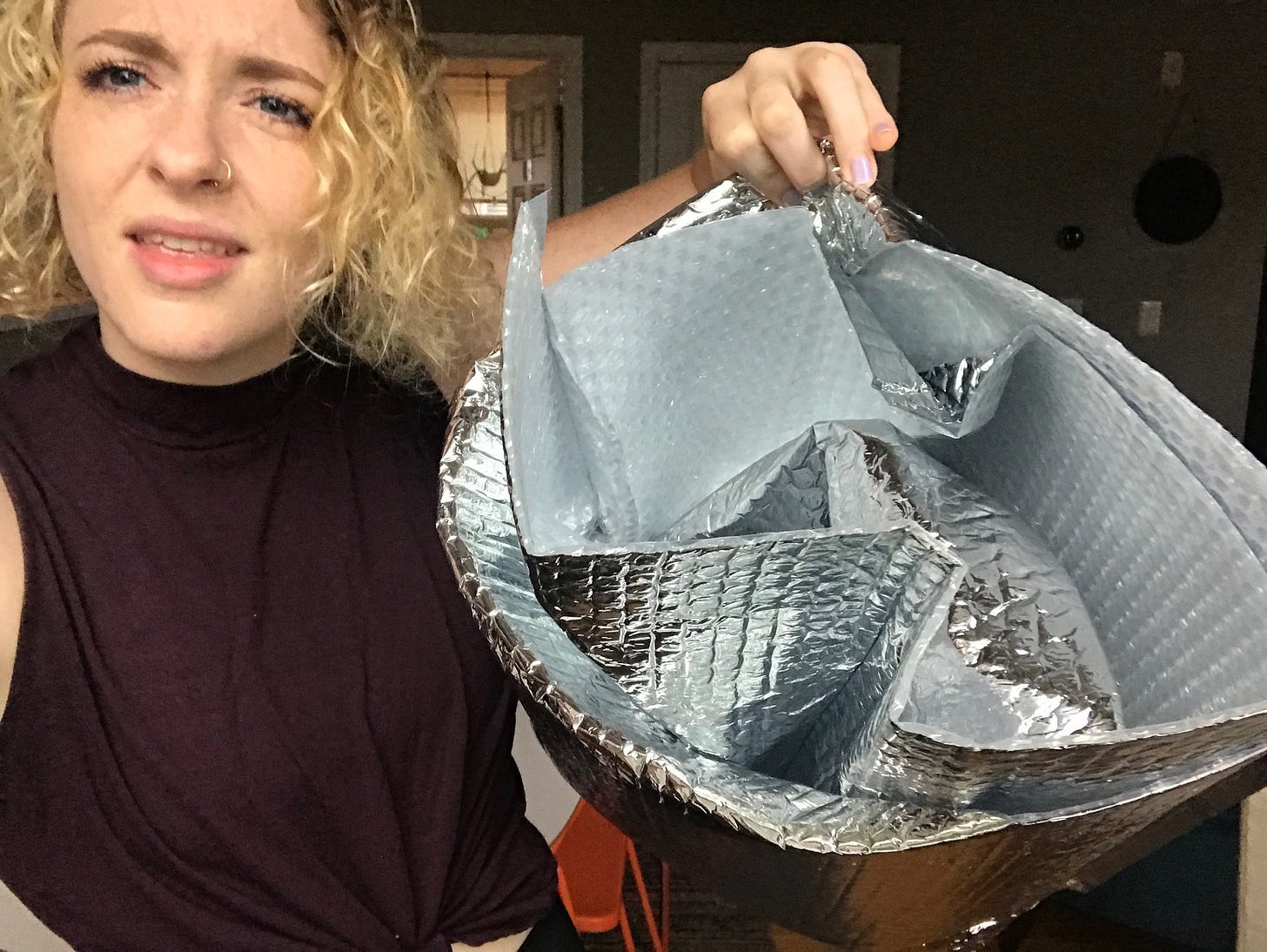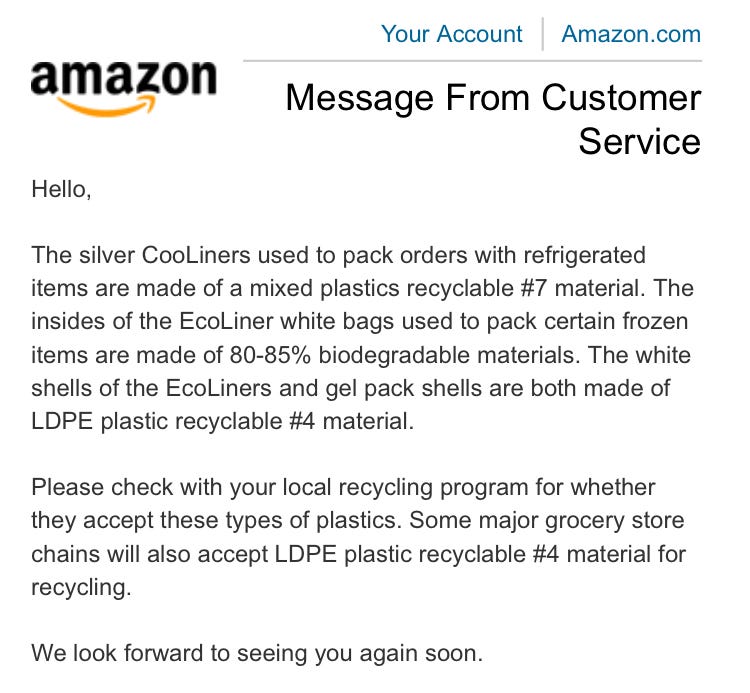Prime Now's freezer bags: an environmental investigation
Amazon says its insulated bags are recyclable. A recycling expert says that's absurd.
Welcome to HEATED, a daily newsletter for people who are pissed off about the climate crisis.
Today’s issue is a bit of a saga, but I think you’ll learn a lot from it. It contains a bunch of previously unreported information about the environmental impact of Amazon Prime’s grocery delivery service, Prime Now. It does this by revealing the materials used in the service’s insulated freezer bags, and critically assessing their recyclability. No other journalism outlet has looked into that before. Who knew? (I knew. That’s why I did it!)
That’s today’s issue. Tomorrow’s issue will examine how this type of packaging waste contributes to the climate crisis, and how both Amazon and its consumers can clean up their acts. It will also include responses from the companies in question, should they choose to get back to me.
It’s all just super fun stuff. So let’s get to it!
A personal prelude to a professional story
The newsletter business has been great so far. Very rewarding, very fulfilling. But getting it off the ground has been almost non-stop work. (Shout-out to my friends for putting up with my unavailability, I love you).
I’ve barely had time to clear my e-mails, much less run basic errands. So when I realized I had nothing in my refrigerator on Saturday, I decided to feed two birds with one scone, and go through e-mails while I waited for two-hour Whole Foods grocery delivery from Amazon Prime Now. (I’m sorry, OK?)
I’ve gotten Whole Foods delivery on Prime Now before. But this time was different. This time, three of the four paper bags I received contained those huge reflective freezer bags—you know the ones I’m talking about. The ones that look like they’re made out of NASA space suit insulation.
And this time, I couldn’t ignore the questions they posed. So I went looking for some answers.

Admin reveal. More awful bag selfies at @heated.world
How does one recycle these things?
With three robot skin totes staring me in the face, I decided to Google how to recycle them so they wouldn’t end up in a landfill. I thought Amazon would probably have easily accessible information on the Prime Now site detailing how to dispose of their packaging in an environmentally conscious way.
I was wrong. The Prime Now site has nothing listed about the insulated freezer bags. However, Amazon Fresh—the site’s more-expensive grocery delivery service—has a small, difficult-to-find section on packaging, which directs consumers to “Reuse or dispose of the insulated bag liners.” Not a good sign for recycling, I thought.
To make sure, I called Amazon Prime customer service. The man who answered told me I had not two, but three options. “You could keep them and re-use them, throw them away, or I can send you some recycling information about them.” Sick, I thought. Recycling information! I chose the third option.
I also asked if he received many calls about the bags. “Yes, we hear a lot about the CooLiners,” he said. “They are a mixed plastic recyclable number 7 material.” Not knowing what that meant—hearing only the word “recyclable”—I said thanks and hung up.
Turns out “mixed plastic recyclable number 7 material” is basically French for “lmao that’s not even remotely recyclable at all.” But more on that later.
Here’s the email the Amazon Prime guy sent me:

I tried to check with my local recycling program—the D.C. Department of Public Works—to see if they took “mixed plastics recyclable #7 material.” I couldn’t get hold of anyone. I called a few times, waited on hold for as long as I humanly could, left a message. At one point, I pleaded with a 311 operator, who told me she didn’t think they took the bags, but that I should find out what type of mixed plastics material they were made of.
The Amazon e-mail didn’t contain specific information on the material of the bags. But I was able to find out what they’re made of anyway, by using an extremely advanced investigative reporting technique.
I Googled “CooLiners.”
What are these things made of?
CooLiners are made by a company called Insulated Products Corp, or IPC. According to a brochure for the product, they are made of two things: “metalized polyester (PET),” which is laminated to stick against “low-density polyethylene (LDPE)” bubbles.
I reached out to both Amazon and IPC to confirm that these are indeed the same CooLiners that come in Whole Foods Prime Now deliveries, but got no response from either company. An IPC customer service representative did, however, give me the email of the person who “manages the Amazon contract.” So I feel pretty confident they’re the same. (Also, they look exactly the same).
IPC’s CooLiners are made from “green, recyclable material,” according to a video for the product. It also says CooLiners are “Easily and cheaply disposed of after use.”
Since I wasn’t able to ask anyone from either company how to recycle these specific materials, I called Susan Collins (Not that Susan Collins). She’s the executive director of the Container Recycling Institute, a nonprofit that researches and promotes recycling of packaging materials. She’s also a manufacturing engineer who spent two decades advising municipalities on recycling. You could say she’s bin recycling for awhile. (Sorry).
I asked Collins how to recycle the CooLiner bags, given the materials. She shot down the prospect almost immediately.
“This would be rejected at any recycling facility,” she said. “Once you have two materials mixed together, it’s not possible to recycle.”
Why, then, are both Amazon and IPC saying these bags are recyclable? Collins said they’re both using tricky language. When Amazon says the bags are “recyclable #7 material,” that just means they’re “miscellaneous plastics,” which are almost never accepted at municipal recycling systems. When IPC says the bags are made of “recyclable material,” that just means the two materials are separately recyclable.
It’s true: Alone, metalized polyester (PET) is a #1 recyclable material, which is easy to recycle and accepted at most facilities. Alone, low-density polyethylene (LDPE) is a #4 recyclable material, which less easy to recycle than a #1 material, but accepted at more facilities than a #7 material.
However, “Once the two items are fused together, they're not recyclable,” Collins said.
In other words, pretty much all of these Amazon Prime Now spaceship bags that keep your eggs cold for two hours are just straight-up going into landfills.
How many Prime Now freezer bags are going to the landfill per year?
It’s impossible to quantify precisely based on publicly available information.
But Prime Now from Whole Foods is available in 75 metropolitan markets nationwide, according to Supermarket News, a real website that I did not make up. And that’s enough information for a thought experiment.
Let’s say 1,000 people in each of those 75 markets receives Amazon Prime Now grocery delivery from Whole Foods once a week, like many of my friends in D.C. do.
Now let’s say each weekly delivery includes one non-recyclable alien clown suit bag. (Mine included three, but I want to be conservative).
That would be 75,000 people receiving 52 insulated bags per year — or 3.9 million freezer bags thrown in the trash annually.
And for what?
Is this Amazon’s fault, IPC’s fault, or mine?
I’m not saying I’m a saint here. I knew these useless petro-state vomit bags came with the Prime Now groceries when I ordered them. I had a feeling they were probably not recyclable.
But damn, thank God it’s literally my job to figure out whether they’re recyclable or not, because figuring out whether they’re recyclable would have taken the average person all day. And the average person may have even come away from their research thinking these bags were recyclable, based on Amazon and IPC’s claims on their website.
Collins thinks these misleading claims of recyclability could be more than serious than they appear. “It could be a violation of the Federal Trade Commission’s Green Guide,” she said. “These folks could have some kind of legal action on their hands if they’re claiming a material is recyclable when it's not.”
A spokesperson for the FTC told me the agency “can’t comment about specific products or companies,” but pointed me to its guidelines for environmental marketing on recycling. Those guidelines state:
Marketers should qualify recyclable claims when recycling facilities are not available to at least 60 percent of the consumers or communities where a product is sold.
The lower the level of access to appropriate facilities, the more a marketer should emphasize the limited availability of recycling for the product.
If recycling facilities for a product are not available to at least 60 percent of consumers or communities, a marketer can state, "This product may not be recyclable in your area." If recycling facilities for a product are available to only a few consumers, a marketer should use stronger qualifying language: "This product is recyclable only in the few communities that have appropriate recycling programs.”
I’m just saying, I didn’t see any of that on Amazon’s website or IPC’s website.

OK, that’s all for today, but I’ll be back tomorrow morning with more analysis from Collins on how packaging waste like this contributes to the climate crisis, and how both Amazon and its consumers can clean up their acts.
If the companies in question choose to get back to me, tomorrow’s newsletter will also include responses from them.
Have questions or comments about today’s issue, or information I should include in tomorrow’s? E-mail me: emily@heated.world
And if you liked today’s issue, please forward it to a friend! They can sign up for daily emails below.
See ya tomorrow!


